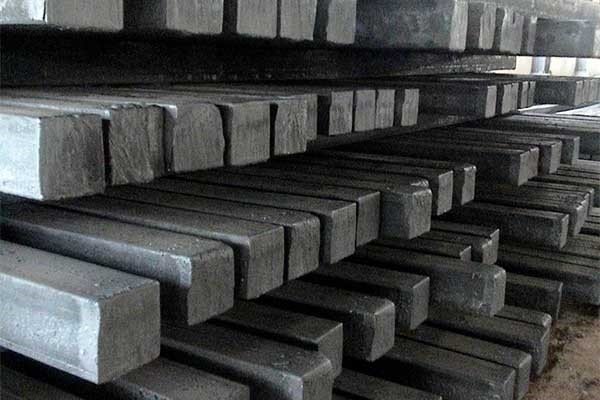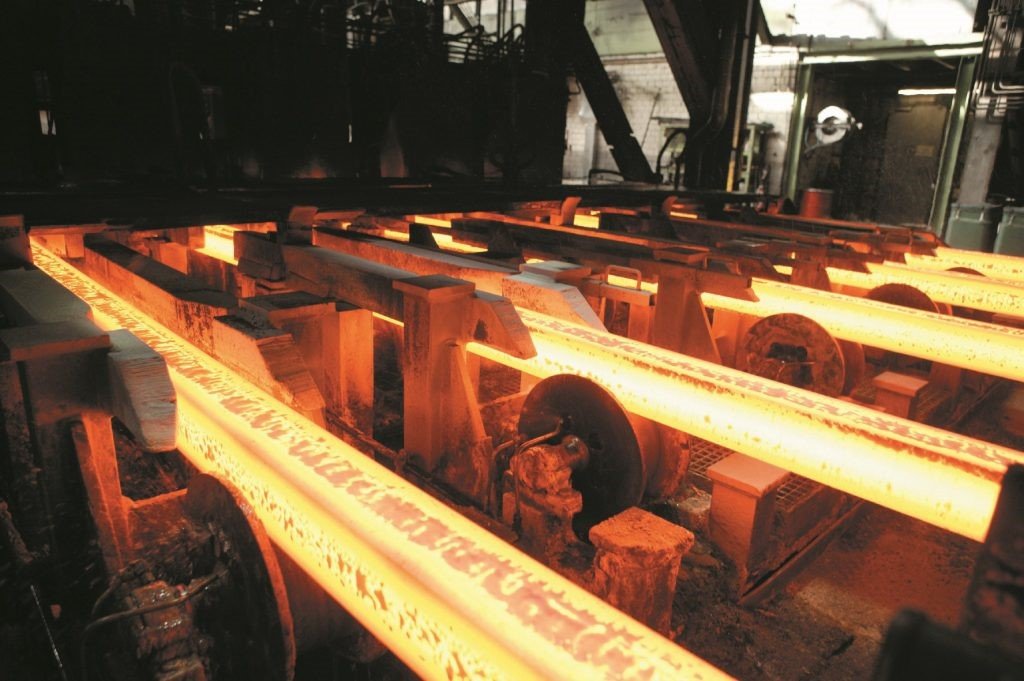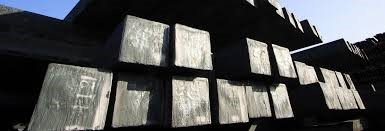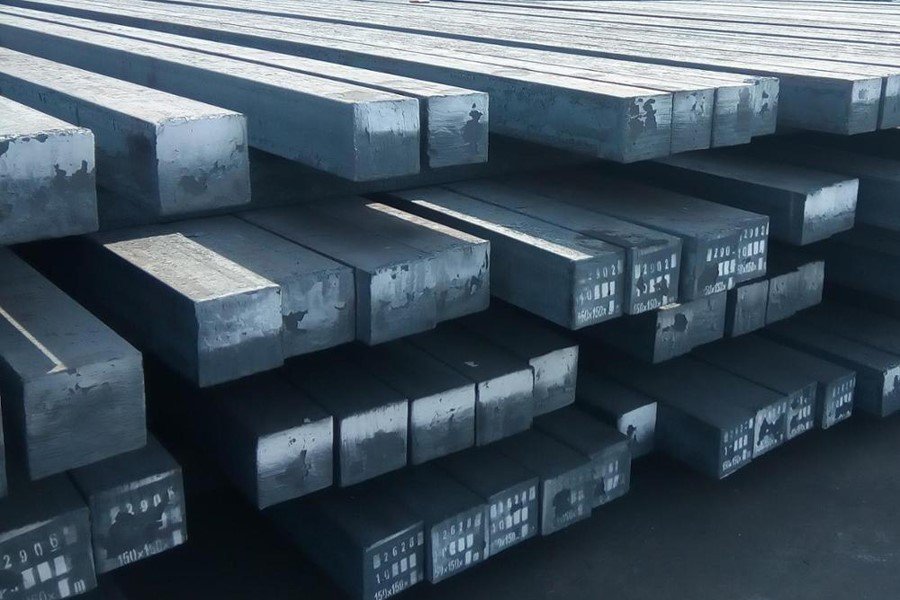A bloom is a semi-finished steel product typically produced through continuous casting. It features a square cross-section, generally exceeding 230 square centimeters, placing it dimensionally between a billet and a slab. Due to its larger size compared to billets, blooms are more suitable for manufacturing heavy and large structural steel components. Common dimensions for blooms include 200×200 mm or 250×250 mm, although sizes can vary based on plant and customer requirements. The length usually ranges from 6 to 12 meters. Blooms consist of iron and specific alloying elements like carbon, manganese, silicon, and phosphorus, tailored to meet the final product’s needs. In technical terms, blooms have a more uniform internal structure compared to older, conventionally cast ingots, leading to improved mechanical properties in finished products. Their higher strength and ability to bear heavy loads make them invaluable in producing rail tracks, heavy I-beams, and large industrial components. Therefore, in infrastructure and construction projects, blooms are often preferred over billets. Overall, blooms play a critical role in the steel production chain, particularly in heavy rolling mills and factories focused on large-section products. The choice between a bloom, billet, or slab depends on the final application, required dimensions, and mechanical performance. When strength, durability, and larger sections are key factors, the bloom emerges as the ideal raw material. Click to view steel bloom.

Methods of Producing Steel Bloom
Steel bloom, a crucial semi-finished product in the steel industry, is primarily manufactured through the Continuous Casting process. In this method, molten steel, refined in either an electric arc furnace or a basic oxygen converter, flows into a continuous casting machine where it solidifies within molds of specified dimensions. These molds, which can be vertical or curved, manage the cooling process, allowing the molten metal to gradually form into a solid bloom. Before casting, the molten steel usually undergoes secondary metallurgy processes like argon purging, deoxidation, or alloying to achieve the desired chemical composition and quality. Once the bloom emerges from the mold, it moves through a series of rollers and is cut into predefined lengths. Continuous casting is dominant due to its high efficiency, consistent internal structure, and excellent surface quality. In the past, ingot casting was utilized to produce blooms by pouring molten steel into static molds to cool and solidify. However, this method has largely been abandoned in modern steel plants due to issues like internal segregation, shrinkage cavities, and the requirement for additional processing. In some instances, blooms are produced by hot rolling larger ingots or slabs, particularly when specific mechanical properties or custom sizes are needed. This alternative is usually employed in plants lacking continuous casting equipment or when creating specialized grades. Ultimately, the method of bloom production is vital in determining the quality, strength, and consistency of the final steel product, with the choice depending on production capacity, technology, and end-use requirements.
Main Applications of Steel Bloom
Steel blooms, with their larger cross-section and distinctive mechanical properties, are essential in the production of heavy and industrial steel products. A primary application of steel blooms is in the construction and structural steel sector. They serve as the raw material for producing beams (I-beams), channels, angles, and other large steel profiles that are integral to building frameworks, warehouses, bridges, and civil engineering projects. Their high load-bearing capacity and structural strength make them an optimal choice in this demanding industry. Another key use of steel blooms is in the rail industry. Their uniform internal structure and substantial dimensions make them perfect for manufacturing railway tracks, metro rails, and rail lines for industrial or mining operations. Blooms offer superior compressive strength and resistance to mechanical stress, ensuring durability under constant vibration and heavy loads. In countries expanding their rail infrastructure, blooms are seen as a strategic component in rail production processes. In addition to these applications, steel blooms are extensively used in the heavy machinery and industrial forging sectors. Many large industrial components like machine frames, heavy-duty rollers, and pressure-bearing parts are created through the rolling or forging of blooms. Their excellent workability and mechanical strength make them ideal for manufacturing large parts that require sustained performance under challenging conditions. Lastly, due to robust international demand, steel blooms maintain a significant role in the export of semi-finished steel products. Neighboring countries of Iran—including Turkey, Iraq, Afghanistan, and several Gulf nations—are prominent export markets. Steel manufacturers in these regions utilize imported blooms as feedstock for rolling mills to produce various structural profiles. Consequently, steel blooms are vital not only in domestic industries but also as a valuable product in the global steel trade. Click to view steel billet

Construction Industry and Steel Structures
The construction and steel structure industry stands as one of the largest and most vital consumers of steel bloom, positioning itself as a key component in the steel production chain. With its larger cross-section and superior mechanical properties, steel bloom is an ideal raw material for producing heavy steel sections. This material is essential in the hot rolling process used to create I-beams (IPE, IPN, HEB), channels, angles, and various special steel profiles. These products form the backbone of structural frameworks in buildings, towers, industrial structures, warehouses, multi-story parking areas, bridges, and even transmission towers. A major advantage of incorporating steel bloom in construction is the capability to produce high-strength profiles across a range of dimensions. Blooms, having a larger cross-section than billets, allow for the manufacture of heavier and more durable sections. This quality is crucial for large-scale engineering projects, especially in seismic regions or areas requiring high load-bearing solutions. Additionally, blooms excel in providing superior bending resistance and compressive strength compared to billets in the final product. In projects involving earthquake-resistant steel frame construction, high-rise bridges, and specialized industrial structures, blooms are often the material of choice. They can be transformed into various engineering profiles that are fundamental for structural analysis. The potential for heat treatments or chemical composition adjustments in steel blooms further enhances the mechanical properties of the end product. With the increasing demand for urban construction, the industrialization of civil engineering projects, and the need for robust and safe structures, the requirement for steel blooms in construction remains steadily high. Many rolling mills in Iran and surrounding regions have set up dedicated production lines to transform blooms into construction profiles, reinforcing the key role of steel blooms in the building sector.
Rail Industry
The rail industry is a pivotal and strategic sector utilizing steel bloom within steel production. Owing to its substantial dimensions and robust strength, steel bloom is an ideal raw material for manufacturing railway rails, which are essential for railway tracks, metro systems, and urban and industrial transport. These rails need specific traits, including compressive and tensile strength, as well as flexibility, to endure heavy loads and pressures along rail paths. A major benefit of using steel bloom in rail manufacturing is its tensile strength and fatigue resistance. Rails must handle dynamic loads and vibrations from trains and other vehicles. Steel blooms, known for their high-quality properties, are considered optimal for producing rails with superior mechanical characteristics. Additionally, the process of rolling and shaping rails from steel bloom ensures a uniform internal structure, resistant to cracking and corrosion. Steel bloom is a crucial raw material for producing railway and metro rails in both developing and developed countries. With growing demand for rail transport and the expansion of metro and train networks, creating high-quality rails that meet international standards necessitates the use of steel bloom. Consequently, steel bloom is vital not only domestically but also in the export of rails to various nations. In summary, the use of steel bloom in the rail industry significantly enhances rail quality and durability while reducing maintenance and repair costs. Employing steel blooms with appropriate mechanical properties extends rail lifespan and prevents failures due to extreme pressures Click to view steel slab.

Heavy Machinery and Industrial Component Manufacturing
The heavy machinery and industrial component manufacturing sector is significantly reliant on steel bloom, which serves as a crucial raw material for crafting large and intricate parts in heavy equipment, industrial machinery, and high-pressure structures. Elements like machine frames, rolling mill rolls, and gears, which operate under extreme pressure, are often produced through the rolling and forging of steel bloom. Given the substantial size and strength requirements of these components, steel bloom is indispensable in their fabrication. A notable advantage of steel bloom in this field is its capacity to be molded into larger, more robust sections, which is essential for parts that endure significant loads and challenging environments. Its uniform internal structure and desirable mechanical properties ensure that the final products possess enhanced strength and longevity. For instance, using steel bloom in manufacturing rolling mill rolls or machine frames guarantees superior quality and performance. In many advanced industrial nations, steel bloom is employed not only domestically but also as a pivotal resource for exporting industrial parts. These exported components find applications in oil, gas, petrochemical, and heavy machinery industries, where they perform complex functions, making the use of top-quality raw materials with ideal mechanical properties critical. Overall, the heavy machinery and industrial component industry is heavily reliant on steel bloom as a primary raw material. The use of steel bloom leads to the production of components that offer high strength, precise specifications, and longer service life, ultimately boosting productivity while reducing maintenance and repair expenses.
Oil, Gas, and Petrochemical Industries
The oil, gas, and petrochemical industries are vital and strategic sectors that rely on steel bloom as a raw material to produce high-strength metal components. These industries demand equipment and parts capable of optimal performance in harsh conditions like high pressures, elevated temperatures, and corrosive environments. Consequently, many components used in these sectors, such as flanges, valves, pressure pipes, heat exchangers, and other heavy industrial equipment, are made from steel bloom. In the oil and gas industries, a significant advantage of steel bloom is its high resistance to pressure and temperature. Components essential for upstream activities, such as oil and gas extraction or refinery operations, must endure extremely high pressures and temperatures. Steel bloom is ideal for manufacturing these parts due to its favorable mechanical properties and uniform internal structure. Additionally, in the petrochemical industry, it is crucial to produce components resistant to corrosion and complex chemical conditions. Many pieces of equipment in this field, including heat exchangers, reactors, and high-pressure pumps, must withstand chemical agents and corrosion. Steel bloom’s specific chemical composition offers excellent resistance under these conditions. Thus, using steel bloom in the oil, gas, and petrochemical industries enhances component strength and durability while reducing maintenance and repair costs. These industries require raw materials with superior mechanical properties that can withstand harsh environments, making steel bloom the optimal choice to meet these demands. Click to view steel billet.

Exports and International Trade
Exports and international trade are fundamental to the use of steel bloom. Due to its technical and economic attributes, steel bloom serves as a raw material in many countries. Nations known for steel production and heavy manufacturing, particularly industrialized ones that need specific sections or large components, value steel bloom for its high-quality mechanical properties in the global marketplace. Exporting steel bloom is crucial for the economic growth of producing nations. Leading steel producers like China, India, Russia, and countries in the Middle East export substantial quantities to worldwide markets. These exports help other nations satisfy their demand for sizable steel sections or heavy components. For example, developing countries and Central Asian nations engaged in large-scale infrastructure projects utilize these blooms to support construction and industrial initiatives. The international trade of steel bloom flourishes partly because of competitive pricing in producing areas like Iran, enabling the product to be available at lower costs globally and therefore boosting demand. Moreover, steel-producing countries can leverage this opportunity to enhance trade partnerships and increase exports of steel and related goods. In global trade, the quality and unique features of steel bloom are crucial in attracting international buyers. Countries using this product across various sectors, especially heavy industries, machinery, petrochemicals, and oil and gas, require blooms capable of enduring extreme conditions and high pressures. Consequently, exporting steel bloom can fulfill the diverse needs of these industries. Lastly, building trade relationships and expanding export markets are significant benefits of utilizing steel bloom in international commerce. Steel bloom can be seen as a strategic asset in the global steel trade, vital for boosting the producing country’s status in world markets.
summary and conclusion
In summary, steel bloom is crucial for various industries due to its exceptional technical attributes. Its larger size and superior mechanical properties make it a popular raw material in producing steel products, particularly in sectors demanding high strength and durability. Steel bloom is essential in fields such as steel construction, rail manufacturing, the oil and gas industry, petrochemicals, and heavy machinery component production. The benefits of using steel bloom—such as its high strength, structural consistency, reduced production costs, and enhanced manufacturing efficiency—enable producers to create durable, high-quality products suitable for challenging conditions. Moreover, exporting steel bloom to international markets addresses the needs of industries worldwide, fostering trade relations and enhancing the exporting nation’s presence in the global market. Ultimately, steel bloom is not only vital for meeting domestic demands but also holds significant importance in international commerce. Its production and export promote economic growth and advance the industries related to steel and its derivatives.

No Comment